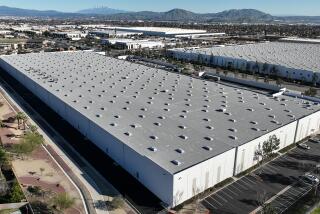Waste-to-Energy Plant Bill Sent to State Senate Floor
SACRAMENTO — A compromise bill that would place strict new air-quality controls on waste-to-energy plants has passed its final committee hurdle and been sent to the floor of the state Senate.
The bill, the lone survivor from a diverse batch of waste-to-energy proposals debated at length this year, passed unchallenged from the Senate Appropriations Committee on Monday.
The bill by Assemblyman Byron D. Sher (D-Palo Alto) would require environmental and health studies for smaller waste-to-energy plants that are not now covered by state law. And, as new emission standards are developed, operators would be required to install more effective pollution controls.
Of the 34 plants proposed statewide, only the three largest, including one planned for Irwindale, are covered by existing state environmental law.
The measure appears to answer the concerns of both the waste-to-energy industry, which had feared a moratorium on construction, and the groups that have criticized as environmentally unsound proposals for incinerators statewide, including one in Long Beach, another in Commerce and several in the San Gabriel Valley.
Organizations as varied as the pro-business California Waste-to-Energy Council, the state Energy Commission, the Coalition for Clean Air and the Miller Brewing Co., which still opposes the Irwindale plant, have all lined up in support of the compromise bill.
Principal Backer of Bill
It also has been backed by area lawmakers, including Sen. Joseph B. Montoya (D-Whittier), who last month withdrew his own proposal and became a principal backer of the current bill.
Even Assemblywoman Sally Tanner (D-El Monte), who had tried to prevent construction of waste incinerators in Irwindale and at the Puente Hills landfill, praised the Sher bill as “the beginning of some laws to govern the waste-to-energy facilities.”
Sher said he expects little opposition on the Senate floor or in the Assembly when the bill returns there next week for approval of Senate amendments.
“We’ve worked hard with all the interested parties,” he said. “Our approach is not to block waste-to-energy projects, as other bills have done, but to ensure that, if they’re built, they are consistent with the health and safety of the public.”
The waste-to-energy plants have been promoted by industry and local governments, including the city of Los Angeles and the Los Angeles County Sanitation Districts, as an alternative to landfills. The incinerators would burn trash and use the resulting steam to produce electricity for sale to utilities. The plants, two of which are already under construction in Long Beach and Commerce, would pay for themselves, backers have maintained.
But in recent months, critics in the San Gabriel Valley and elsewhere have said incinerator emissions, including highly toxic dioxins, will pollute the air and may cause still-unknown health problems.
Under Sher’s bill, plants would be required to upgrade pollution control equipment as state officials complete studies on toxic emissions and set new pollution standards.
Assessment of Health Risks
Sher’s bill also requires an environmental impact report and a detailed assessment of health risks for each project, regardless of size. The state Department of Health Services must find that the plants will cause no significant increase in illness or death.
Under existing law, waste incinerators that generate more than 50 megawatts of electricity are subject to similar stringent environmental reviews by the state Energy Commission. But smaller projects, like the 10-megawatt plant in Commerce and Long Beach’s 20-megawatt facility, need only meet local standards.
A spokesman for the Los Angeles County Sanitation Districts, which are developing eight of the 10 incinerators planned for the county, including those in Long Beach and Commerce, said the agency is already using the Sher bill’s guidelines. Its projects would be feasible even if plant retrofitting were needed to meet new standards for toxic emissions, Sanitation Districts engineer John Gulledge said.
The sanitation agency also is considering two large plants to produce a total of 47 to 235 megawatts at the Puente Hills landfill north of Whittier. It is considering one of 23 megawatts at the Spadra landfill in Pomona, an 8-megawatt facility in South Gate, and a possible plant in the Torrance or Palos Verdes Peninsula area, Gulledge said.
39-Megawatt Plant
A spokesman for the City of Los Angeles, which is planning a 39-megawatt plant in its South-Central area, has said strict environmental and health review guidelines already are being followed. He said, however, that retrofitting could increase costs, now estimated at about $235 million.
The region’s other proposed facility, a highly controversial 80-megawatt facility in Irwindale, has been stalled before the state Energy Commission since April. That application will not be reconsidered until the developer finds ways to compensate for emissions that exceed air-quality standards.
If all plants now planned are constructed, they would burn between 25% and 40% of the 40,000 tons of trash produced countywide each day, depending on the size of the Puente Hills incinerators.
More to Read
Sign up for Essential California
The most important California stories and recommendations in your inbox every morning.
You may occasionally receive promotional content from the Los Angeles Times.










